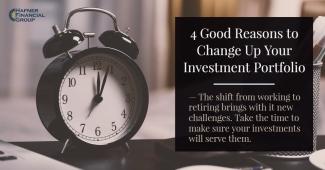
4 Reasons to Change Up Your Investment Portfolio
I often meet families who created an investment portfolio many, many years ago. And while it seems to have performed great during their pre-retirement years, they are sometimes surprised to learn that those same investments may not serve them well in Retirement.

Here are 4 good reasons why the Investment Portfolio you started in your 30s may not be right for retirement:
- Your investments may not have performed as well as you think. 20 or 30 years is a long time. Over that time, even sub-par investment performance might seem quite impressive. If you want to be sure your investments are performing as well as they should, you need to compare their performance to the appropriate benchmarks. That is the only way you can tell if your investments have done as well as they should have.
- Your old investments may have high fees. Many things have changed over the last 30 years. One of the most significant for investors is that fees have dropped considerably. Back in the 1990s, it wasn’t uncommon to pay more than 5% to simply get into a mutual fund. And that doesn’t even include the internal and ongoing costs you were charged every year. But with the advent of no-load mutual funds and low-cost ETFs *, investors creating or refreshing their investment portfolio today may be able to significantly reduce the cost of investing. The result is that you could be putting more money in your own pocket.
Time is no longer on your side. When you started your investment portfolio, you were a young growth investor and time was on your side. In large part, all you needed to be successful was to keep on adding to your investments and not panic out of them when the markets were volatile. After all, the markets go up far more often than they go down and they have never failed to recover from a correction and go on to new highs. (For more on volatile markets read “Should I Be Worried About the Volatile Stock Market”) *
But now that you are approaching retirement and will need to draw money out of your investments, you no longer have the luxury of time to wait for your investment to rebound. Once you retire, your investments need to be aligned with a strategy that allows you to take money out whether your investments are up or down. (For more info on income strategies in Retirement read “Income in Our Golden Years”)- Social Security will not be enough. Most people plan to collect Social Security once they stop working. However, you should only expect Social Security to replace about 40% of your working income. So, once you stop working, your investment portfolio will need to replace this missing 60%. And not only will you need to get this income out of your investments, you will also need to make sure the portfolio grows enough to keep up with inflation, so you can give yourself a raise in the future. Balancing these 2 goals is a far more complicated proposition and probably requires some changes to your Investment portfolio. *
Once you’re ready to make the big shift from working to retiring, it’s important to take the time and make sure you’ve got the right investments for these new challenges. * Lower costs and/ or fees do not assure better performance. Consult with your financial advisor prior to making a choice on your investments. Past performance is no assurance of future results.

